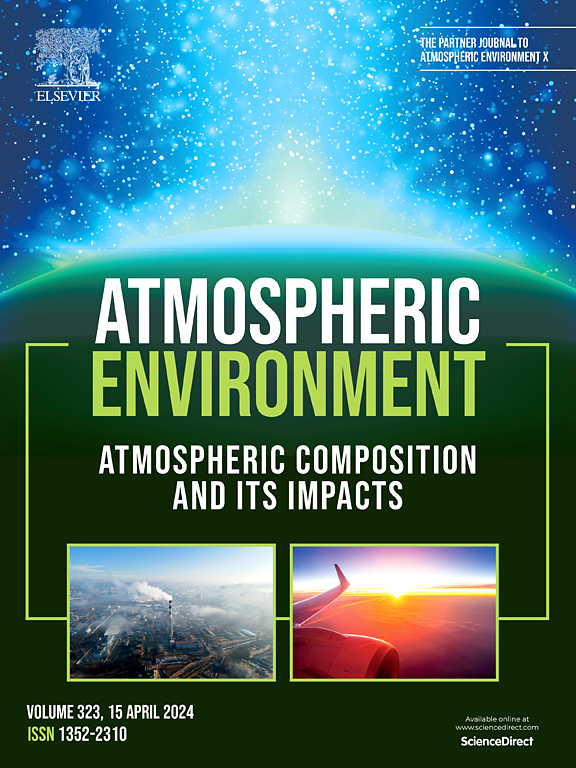A twin site study of size-resolved composition, source apportionment and health impacts of aerosol particles in Morocco
IF 3.7
2区 环境科学与生态学
Q2 ENVIRONMENTAL SCIENCES
引用次数: 0
Abstract
This study provides new information on the chemical composition, source contributions, and health implications of size-resolved ultrafine, fine, and coarse mode particles through a comparative assessment at two contrasting sites in Morocco: the rural Atlas Mohammed V (AMV) observatory and the urban city of Fez. During September–October 2019, PM10 concentrations at Fez (32 ± 7.8 μg m−3) were nearly three times higher than at AMV (12 ± 6.4 μg m−3), with urban ultrafine particles (<0.1 μm) contributing 30 % of PM10 compared to only 12 % at the AMV observatory. Source apportionment results revealed that vehicular exhaust was the main contributor (34 %) to ultrafine particles at FEZ, while a total traffic-related factor, including both exhaust and non-exhaust emissions, dominated at AMV (37 %), indicating long-range transport of urban traffic pollutants. Both sites showed substantial biomass burning influence (ca. 40 %) in fine particles and mineral dust dominance (>50 %) in coarse fractions (1.2–10 μm). Source contributions varied across different air mass origins, suggesting local emissions as primary drivers of pollution, with long-range transport predominantly enhancing background concentrations rather than introducing new source types in the studied regions. Diagnostic ratios indicated that fresh traffic emissions dominated PAH composition in Fez, while mixed petroleum and combustion sources were the dominant sources at AMV. Health risk assessments revealed elevated non-carcinogenic risks in Fez, particularly from traffic-related metals (Ni, Zn). These findings address critical data gaps in North African air quality research and provide essential baseline information to support targeted emission control strategies and public health policies in rapidly urbanizing regions.
摩洛哥气溶胶颗粒的尺寸分解组成、来源分配和健康影响的双站点研究
本研究通过在摩洛哥两个不同地点(农村阿特拉斯穆罕默德五世(AMV)天文台和城市非斯市)的比较评估,提供了关于尺寸分解超细、细和粗模式颗粒的化学成分、来源贡献和健康影响的新信息。在2019年9月至10月期间,非斯的PM10浓度(32±7.8 μg m - 3)比AMV(12±6.4 μg m - 3)高出近3倍,其中城市超细颗粒(0.1 μm)占PM10的30%,而AMV天文台仅占12%。源解析结果表明,车辆尾气是自由贸易区超细颗粒物的主要来源(34%),而包括尾气和非尾气排放在内的交通相关总因素在AMV中占主导地位(37%),表明城市交通污染物的远程运输。两个站点在细颗粒(1.2-10 μm)中都显示了大量生物质燃烧的影响(约40%),而在粗颗粒(1.2-10 μm)中则显示了矿物粉尘的优势(> 50%)。不同气团来源的源贡献各不相同,表明本地排放是污染的主要驱动因素,在研究区域,远程输送主要是提高本底浓度,而不是引入新的源类型。诊断比值表明,非斯的多环芳烃成分以新鲜交通排放为主,而混合石油和燃烧源是AMV的主要来源。健康风险评估显示,非斯的非致癌风险升高,特别是来自与交通有关的金属(镍、锌)。这些研究结果填补了北非空气质量研究中的关键数据空白,并提供了基本的基线信息,以支持快速城市化地区有针对性的排放控制战略和公共卫生政策。
本文章由计算机程序翻译,如有差异,请以英文原文为准。
求助全文
约1分钟内获得全文
求助全文
来源期刊

Atmospheric Environment
环境科学-环境科学
CiteScore
9.40
自引率
8.00%
发文量
458
审稿时长
53 days
期刊介绍:
Atmospheric Environment has an open access mirror journal Atmospheric Environment: X, sharing the same aims and scope, editorial team, submission system and rigorous peer review.
Atmospheric Environment is the international journal for scientists in different disciplines related to atmospheric composition and its impacts. The journal publishes scientific articles with atmospheric relevance of emissions and depositions of gaseous and particulate compounds, chemical processes and physical effects in the atmosphere, as well as impacts of the changing atmospheric composition on human health, air quality, climate change, and ecosystems.
 求助内容:
求助内容: 应助结果提醒方式:
应助结果提醒方式:


